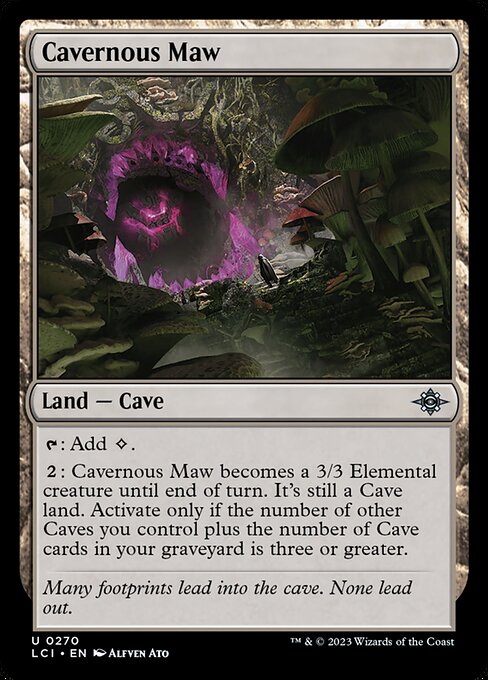
Image courtesy of Scryfall.com
Cavernous Maw: How Set Types Shape Meta Presence
Magic: The Gathering has always rewarded players who read the room—the set type, the theme of a block, and the way a card fits into a broader ecosystem all shape how often a card shows up in decks, and where those decks actually shine. Cavernous Maw sits at an intriguing crossroad: a land that can morph into a 3/3 creature, with a threshold that leans heavily on the surrounding “Cave” theme found in The Lost Caverns of Ixalan. In a meta that often treats lands as quiet economy rather than explosive threats, this card nudges us to consider how set design can push certain mechanics into the spotlight, even if they’re not flashy on the surface. 🧙🔥💎
A land with a double life
From a gameplay perspective, Cavernous Maw is a rare kind of multi-use tool. On its face, it provides colorless mana, which is as neutral as a card can get. But the second part of its text—“This land becomes a 3/3 Elemental creature until end of turn. It's still a Cave land. Activate only if the number of other Caves you control plus the number of Cave cards in your graveyard is three or greater”—turns a land into a tempo engine, a chump-blocker, and sometimes a surprise damage outlet all in one. This kind of layered utility is a direct reflection of Ixalan’s overarching cave-and-sunken-ruins motif, but it also demonstrates how a set’s thematic focus can push a niche card into moments of real meta relevance. ⚔️
“Many footprints lead into the cave. None lead out.”
The flavor text isn’t just mood—it hints at a design philosophy: thresholds matter. In a set where exploration, subterranean hazards, and the conscription of cave-dwellers are narrative signals, Cavernous Maw rewards players who lean into those signals with cards that reward land-based strategies and graveyard interaction. The Lost Caverns of Ixalan is an expansion set, not a core-set reprint, so its cards are more likely to appear in decks that are tuned to its own thematic gravity rather than being splashable everywhere. This distinction matters when considering meta presence. 🧭🎨
Set Type, Theme, and Real-World Impact on the Meta
Set type is more than a label; it’s a lens through which players evaluate value. Expansion sets like The Lost Caverns of Ixalan tend to introduce idiosyncratic triggers, tribal synergies, or limited-playable themes that aren’t always practical in many constructed formats. Cavernous Maw thrives when the player has multiple caves in play or graveyard-ready cave cards, which is exactly the kind of niche the Ixalan line embraced. In Limited, where theme and synergy often carry more weight than raw power, a land that can flip into a 3/3 is a legitimate tempo play. In Constructed formats, the card becomes a tactical piece for decks that explicitly chase cave-centric or graveyard-reliant strategies. The result is a meta presence that’s real, but specialized—quietly influential in decks that lean into the set’s core idea. 🧙♂️💎
Archetypes and shells that benefit
- Cave-focused Commanders and EDH: In Commander, Cavernous Maw can slot into “cave” or subterranean-themed pods, where players are incentivized to maximize land interactions and graveyard value. The ability to turn a land into a creature adds interaction that scales when you’re playing big, grindy games with lots of mana rocks. 🎲
- Graveyard-forward decks: The condition involving graveyard cards makes Maw a natural fit for decks that populate the graveyard and then leverage it for value, ramp, or defense. It’s a gentle nudge toward a midrange tempo plan, rather than a straight-up combo starter. 🧙🔥
- Lifestyle of green-lighted colorless hate: Since Cavernous Maw is colorless and not tied to a specific color, it can thread into various color combinations. This flexibility is valuable in a meta that prizes cross-color interaction and multi-color ramp. ⚔️
Why rarity and availability matter for meta presence
As an uncommon from an expansion set, Cavernous Maw tends to sit on the periphery of mainstream modern decks but can become a recurring feature in niche builds. The card’s price trend tends to reflect its specialized use rather than broad demand, making it a curiosity for collectors and a practical pick for players pursuing a specific cave-graveyard synergy. The EDHREC rank—sitting in the mid-to-lower tier—signals that while it isn’t a staple, it has a loyal, if selective, following among commanders who enjoy creative land-based engines. The “foil” and “nonfoil” availability also contribute to its collector appeal, with foils often showing up in casual and EDH games where display-worthy cards get their moment in the sun. 🧩
Beyond the Card: art, lore, and the cultural texture of set-driven meta
Alfven Ato’s illustration for Cavernous Maw captures the claustrophobic, hungry ambiance of Ixalan’s underworld—an art direction that resonates with players who grew up loving the “cavern” vibe. The flavor text reinforces a sense of mystery and danger that invites players to build narratives around exploration and risk. This is the kind of card that invites casual storytelling as much as competitive math, a hallmark of how set-driven design can enrich the metagame by giving players a strong, flavorful canvas to paint on. And when you’re collecting or trading, the rarity and set-specific aesthetics add another layer of depth to your MTG journey. 🎨🧙♀️
Where to find and try Cavernous Maw in your next game night
If you’re curious to test the water with cave-focused synergies, consider starting with a Commander game night or a small-burst Modern-leaning deck that toys with land-based tempo. Look for other caves in your graveyard with Cavernous Maw as your bridge between mana economy and late-game pressure. And while you’re exploring the tactile side of MTG culture, you might also discover a different kind of treasure—pocket-sized gear that keeps you organized between games. For example, this slim, glossy accessory you can check out here: the product linked below offers practical style for your daily carry while you draft or lay out a turn plan. 🧙♂️💎